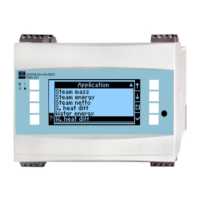RMS621 Commissioning
Endress+Hauser 37
Factor K-factor for describing the resistance coefficient of E+H Pitot
tubes (see data sheet).
Correction Yes
No
Possibilities for correcting the flow measurement by offset,
signal damping, flow cut off, expansion coefficient of the
device (e.g. orifice plate) and correction table for curve
description.
Flow cut off 0.0 to 99.9%
4.0 %
Below the set value, the flow is no longer recorded or 0 is set.
Depending on the type of flow transmitter, the flow cutoff can
be set in % of the full scale value of the flow measuring range
or as a fixed flow value (e.g. in m
3
/h).
Signal damp 0 to 99 s Time constant of the first order low pass for the input signal.
This function is used to reduce display fluctuations in the event
of severely fluctuating signals.
!
Note!
This can only be selected for the 0/4 to 20 mA signal.
Offset -9999.99 to 9999.99 Shifts the zero point of the response curve. This function is
used to adjust sensors.
!
Note!
This can only be selected for the 0/4 to 20 mA signal.
Table Use
Not used
If the flow curve of your transmitter deviates from the ideal
pattern (linear or square root), this can be compensated by
entering a correction table.
For details, see Setup ’Flow inputs’.
Pipe data Inner dia.
Geom. ratio
Enter the internal diameter of the pipe.
Enter the diameter ratio (d/D = ß) of the differential pressure
transmitter, data in the data sheet of the DP transmitter.
!
Note!
In dynamic pressure measurements, the K-factor must be given
to describe the resistance coefficient of the probe (see Section
11.2.1 for details).
Coefficient Fixed value
Table
Flow coefficient c for calculating the flow.
!
Note!
Only if using a V-cone flow transmitter.
Coeff. (c) 0.0001 to 99999 Enter the flow coefficient c.
Num. coeff. 01 - 15 Number of points in the table.
Coeff. tab. Points
(used/delete)
Reynolds No./coefficient
Table for describing the flow coefficient depending on the
Reynolds number.
For details on the V-cone calculation method, see
Section 11.2.1
Sums Unit
Format
Actual
Total
Signal reset
Terminals
See Setup ’Flow inputs’
Splitting range
Splitting range Splitting range or automatic measuring range switching for
differential pressure measuring devices.
See Section 11.2.1 for details of the 'Splitting Range'.
Rng.1 Term. A-10; A-110; B-112;
B-113; C-112; C-113; D-
112; D-113
Terminal for connecting the differential pressure transmitter
with the smallest measuring range
Rng.2 Term. A-10; A-110; B-112;
B-113; C-112; C-113; D-
112; D-113
Terminal for connecting the differential pressure transmitter
with the second largest measuring range
Rng.3 Term. A-10; A-110; B-112;
B-113; C-112; C-113; D-
112; D-113
Terminal for connecting the differential pressure transmitter
with the largest measuring range
Function (menu item) Parameter setting Description

